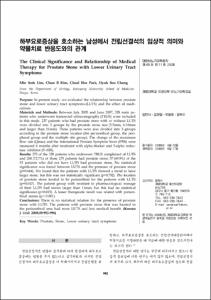하부요로증상을 호소하는 남성에서 전립선결석의 임상적 의미와 약물치료 반응도와의 관계
- Keimyung Author(s)
- Kim, Chun Il; Park, Choal Hee; Chang, Hyuk Soo
- Department
- Dept. of Urology (비뇨의학)
- Journal Title
- Korean Journal of Urology
- Issued Date
- 2008
- Volume
- 49
- Issue
- 11
- Keyword
- Prostate; Stone; Lower urinary tract symptoms
- Abstract
- Purpose: In present study, we evaluated the relationship between prostate stone and lower urinary tract symptoms (LUTS) and the effect of medications. Materials and Methods: Between July 2005 and June 2007, 328 male patients who underwent transrectal ultrasonography (TRUS) were included in this study. 237 patients who had prostate stone with or without LUTS were divided into 3 groups by the prostate stone size (3-5mm, 6-10mm and larger than 11mm). These patients were also divided into 3 groups according to the prostate stone location (the periurethral group, the peripheral group and the multiple site group). The change of the maximum flow rate (Qmax) and the International Prostate Symptom Score (IPSS) were measured 6 months after treatment with alpha-blocker and 5-alpha reductase inhibitor (5-ARI). Results: 275 of the 328 patients who underwent TRUS complained of LUTS and 200 (72.7%) of these 275 patients had prostate stone; 37 (69.8%) of the
53 patients who did not have LUTS had prostrate stone. No statistical significance was found between LUTS and the presence of prostate stone
(p=0.664). We found that the patients with LUTS showed a trend to have larger stone, but this was not statistically significant (p=0.792). The location of prostate stone tended to be periurethral for the patients with LUTS (p=0.047). The patient group with resistant to pharmacological manage of their LUTS had stones larger than 11mm, but this had no statistical significance (p=0.615). A lesser therapeutic result was related with periurethral stones (p<0.001). Conclusions: There is no statistical relation for the presence of prostate stone with LUTS. The patients with prostate stone that was located in the periurethral area had more LUTS and less medical benefit.
- Alternative Title
- The Clinical Significance and Relationship of Medical Therapy for Prostate Stone with Lower Urinary Tract Symptoms
- Publisher
- School of Medicine
- Citation
- Min Seek Lim et al. (2008). 하부요로증상을 호소하는 남성에서 전립선결석의 임상적 의미와 약물치료 반응도와의 관계. Korean Journal of Urology, 49(11), 992–996. doi: 10.4111/kju.2008.49.11.992
- Type
- Article
- ISSN
- 0494-4747
- Appears in Collections:
- 1. School of Medicine (의과대학) > Dept. of Urology (비뇨의학)
- 파일 목록
-
-
Download
 oak-aaa-03625.pdf
기타 데이터 / 584.4 kB / Adobe PDF
oak-aaa-03625.pdf
기타 데이터 / 584.4 kB / Adobe PDF
-
Items in Repository are protected by copyright, with all rights reserved, unless otherwise indicated.